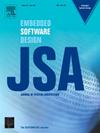Input/mapping precision controllable digital CIM with adaptive adder tree architecture for flexible DNN inference
IF 3.7
2区 计算机科学
Q1 COMPUTER SCIENCE, HARDWARE & ARCHITECTURE
引用次数: 0
Abstract
Digital compute-in-memory (CIM) systems, known for their precise computations, have emerged as a viable solution for real-time deep neural network (DNN) inference. However, traditional digital CIM systems often suffer from suboptimal array utilization due to static multi-bit input/mapping dataflows and inflexible adder tree structures, which do not adequately accommodate the diverse computational demands of DNNs. In this paper, we introduce a novel digital CIM architecture that dynamically redistributes bit precisions across the input and mapping domains according to computational load and data precision, thereby improving array utilization and energy efficiency. For supporting flexible bit configurations, the system incorporates an adaptive adder tree with the integrated bit-shift logic. To minimize potential overhead introduced by the bit-shiftable adder tree, we also propose a grouping algorithm that efficiently executes shift and add operations. Simulation results show that our proposed methods not only improve array utilization but also significantly accelerate computation speed, achieving up to a 10.46 speedup compared to traditional methods.
求助全文
约1分钟内获得全文
求助全文
来源期刊

Journal of Systems Architecture
工程技术-计算机:硬件
CiteScore
8.70
自引率
15.60%
发文量
226
审稿时长
46 days
期刊介绍:
The Journal of Systems Architecture: Embedded Software Design (JSA) is a journal covering all design and architectural aspects related to embedded systems and software. It ranges from the microarchitecture level via the system software level up to the application-specific architecture level. Aspects such as real-time systems, operating systems, FPGA programming, programming languages, communications (limited to analysis and the software stack), mobile systems, parallel and distributed architectures as well as additional subjects in the computer and system architecture area will fall within the scope of this journal. Technology will not be a main focus, but its use and relevance to particular designs will be. Case studies are welcome but must contribute more than just a design for a particular piece of software.
Design automation of such systems including methodologies, techniques and tools for their design as well as novel designs of software components fall within the scope of this journal. Novel applications that use embedded systems are also central in this journal. While hardware is not a part of this journal hardware/software co-design methods that consider interplay between software and hardware components with and emphasis on software are also relevant here.
 求助内容:
求助内容: 应助结果提醒方式:
应助结果提醒方式:


